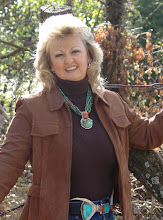
Although not an indigenous art form, silversmithing designs brought to the Southwest by Spanish and Mexican soldiers became important parts of Navajo life.
Atsidi Sani (the Old Smith), first Navajo credited with silversmithing, learned the craft from a Mexican smith as early as 1853. Soon the Navajo sought not only the caballeros bridles and iron bits, but also Spanish rosaries, necklace, crosses, beads, and bells, changing the styles into their own. Life on the reservation meant that prestige and wealth could no longer come from raiding.
A new lifestyle evolved as warriors became herders and, in their free time, silversmiths. Around 1870, Navajo smiths began hammering out U.S. and Mexican coins, then stamping and engraving the metal with designs. By the so-called Classic Period of Navajo silversmithing (1880-1900), the art was mastered and silversmiths created concha belts, bracelets, bridle decoration, and naja necklaces for their own joy and prestige.
In 1872, Lanyade, a Zuni, learned silverworking from a Navajo smith named Atsidi Chon, and soon the Zuni were taking the craft in their own direction. By 1890, Zuni silverwork consisted primarily of settings for turquoise.
In 1898, Lanyade passed the craft on to a Hopi artist, Sikyatata. Early Hopi silverwork resembled that of the Navajo. However, in 1938, Dr. Harold S. Colton and Mary Russell Colton, founders of the Museum of Northern Arizona encouraged Hopi silversmiths to apply their famous pottery, basket and kasina mask designs to silverwork. The Hopi developed a distinct style called overlay wherein two sheets of silver were layered, the top one cut with an openwork design while the lower one is blackened or etched to emphasize the design.
The wonderful bracelet is a perfect example of the overlay process.
Hope you enjoyed the short history lesson. The information is courtesy of Lois Sherr Dubin who has done year of research into North American Indian Jewelry and Adornment.
Thanks for visiting!!
Gayla
